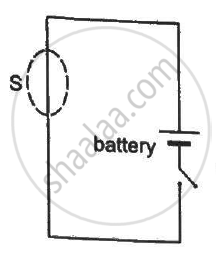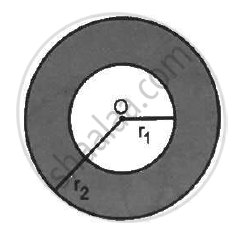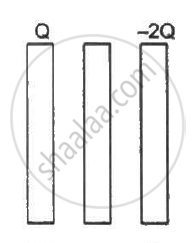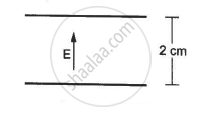Advertisements
Advertisements
प्रश्न
The radius of a gold nucleus (Z = 79) is about 7.0 × 10-10 m. Assume that the positive charge is distributed uniformly throughout the nuclear volume. Find the strength of the electric field at (a) the surface of the nucleus and (b) at the middle point of a radius. Remembering that gold is a conductor, is it justified to assume that the positive charge is uniformly distributed over the entire volume of the nucleus and does not come to the outer surface?
उत्तर
Given:
Atomic number of gold = 79
Charge on the gold nucleus, Q = 79 × (1.6 ×10-19) C The charge is distributed across the entire volume. So, using Gauss's Law, we get:
(a) `phi =oint vec"E". vec("d""s") = "Q"/∈_0`
`=> oint "E""d""s" = "Q"/∈_0`
The value of E is fixed for a particular radius.
`=> "E" oint "d""s" = "Q"/∈_0`
`=> "E" xx 4 pi "r"^2 ="Q"/∈_0`
`=> "E" ="Q"/(∈_0 xx 4 pi "r"^2)`
`"E" = ( 79 xx (1.6 xx 10^-19 ))/((8.85 xx 10^-12) xx 4 xx 3.14 xx ( 7 xx 10^-10)^2`
`"E" = 2.315131 xx 10^21 "N"//"C"`
(b) To find the electric field at the middle point of the radius:
Radius , `"r" = 7/2 xx 10^-10 m`
Volume, `"V" = 4/3 pi "r"^3`
`=4/3 xx 22/7 xx 343/8 xx 10^-30`
Net charge =79 ×1.6 ×10-19 C
Volume charge density
`= (79 xx 1.6 xx 10^-19)/(4/3pi xx 343 xx 10^-30) `
So, the charge enclosed by this imaginary sphere of radius r =3.5× 10 -10
`= (79 xx 1.6 xx 10^-19)/(4/3pi xx 343 xx 10^-30) xx 4/3 pi xx 343/8 xx 10^-30 `
`= (79 xx 1.6 xx 10^-19)/8`
`=> "E" = (79 x 1.6 xx 10^-19)/(8 xx4pi ∈_0."r"^2)` at r = 3.5× 10-10
= 1.16 × 1021 N/C.
As electric charge is given to a conductor, it gets distributed on its surface. But nucleons are bound by the strong force inside the nucleus. Thus, the nuclear charge does not come out and reside on the surface of the conductor. Thus, the charge can be assumed to be uniformly distributed in the entire volume of the nucleus.
APPEARS IN
संबंधित प्रश्न
plot a graph showing the variation of current density (j) versus the electric field (E) for two conductors of different materials. What information from this plot regarding the properties of the conducting material, can be obtained which can be used to select suitable materials for use in making (i) standard resistance and (ii) connecting wires in electric circuits?
Plot a graph showing the variation of resistivity of a conductor with temperature.
Why is the potential inside a hollow spherical charged conductor constant and has the same value of as on its surface?
A closed surface S is constructed around a conducting wire connected to a battery and a switch in the following figure. As the switch is closed, the free electrons in the wire start moving along the wire. In any time interval, the number of electrons entering the closed surface S is equal to the number of electrons leaving it. On closing the switch, the flux of the electric field through the closed surface
(a) is increased
(b) is decreased
(c) remains unchanged
(d) remains zero

Show that there can be no net charge in a region in which the electric field is uniform at all points.
The electric field in a region is given by
`vec"E"= 3/5"E"_0 vec"i" + 4/5 "E"_0 vec "i" "with" " E"_0 = 2.0 xx 10^3 "N""C"^-1.`
Find the flux of this field through a rectangular surface of area 0⋅2 m2 parallel to the y-z plane.
The electric field in a region is given by `vec"E" = ("E"_0 "x")/"l" vec"i".`
Find the charge contained inside the cubical volume bound by the surfaces
x =0, x =a, y=0, y=a, z=0 and z=a. Take
`"E"_0 = 5 xx 10^3 "N""C"^-1 , "l" =2 "cm" " and" " a" = 1 "cm" `
A charge Q is distributed uniformly within the material of a hollow sphere of inner and outer radii r1 and r2 (see the figure). Find the electric field at a point P at a distance x away from the centre for r1 < x < r. Draw a rough graph showing the electric field as a function of x for 0 < x < 2r2 (see the figure).

A non-conducting sheet of large surface area and thickness d contains a uniform charge distribution of density ρ. Find the electric field at a point P inside the plate, at a distance x from the central plane. Draw a qualitative graph of E against x for 0 < x < d.
A charged particle with a charge of −2⋅0 × 10−6 C is placed close to a non-conducting plate with a surface charge density of 4.0 × 10-6Cm0-2. Find the force of attraction between the particle and the plate.
One end of a 10 cm long silk thread is fixed to a large vertical surface of a charged non-conducting plate and the other end is fastened to a small ball of mass 10 g and a charge of 4.0× 10-6 C. In equilibrium, the thread makes an angle of 60° with the vertical (a) Find the tension in the string in equilibrium. (b) Suppose the ball is slightly pushed aside and released. Find the time period of the small oscillations.
Three identical metal plates with large surface areas are kept parallel to each other as shown in the following figure. The leftmost plate is given a charge Q, the rightmost a charge −2Q and the middle one is kept neutral. Find the charge appearing on the outer surface of the rightmost plate.

A uniform electric field of 10 N C−1 exists in the vertically downward direction. Find the increase in the electric potential as one goes up through a height of 50 cm.
An electric field of magnitude 1000 NC−1 is produced between two parallel plates with a separation of 2.0 cm, as shown in the figure. (a) What is the potential difference between the plates? (b) With what minimum speed should an electron be projected from the lower place in the direction of the field, so that it may reach the upper plate? (c) Suppose the electron is projected from the lower place with the speed calculated in part (b). The direction of projection makes an angle of 60° with the field. Find the maximum height reached by the electron.

Answer the following question.
Prove that the average energy density of the oscillating electric field is equal to that of the oscillating magnetic field.
When a comb rubbed with dry hair attracts pieces of paper. This is because the ______.
